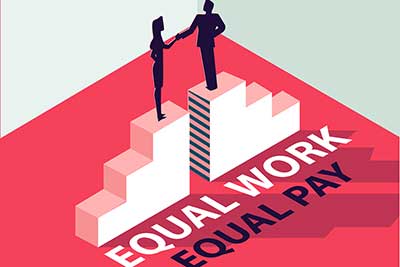Relevance: GS-1: Role of women and women’s organization, population and associated issues
Relevance: GS-2: Indian Constitution—Historical Underpinnings, Evolution, Features, Amendments, Significant Provisions and Basic Structure.
Key Phrases: Article 39(d), Preamble, Article 14, Article 15, Randhir Singh v UOI, Equal Remuneration Convention, 1951, European Social Charter
Why in News?
- The Himachal Pradesh High Court has held that the provision of 'equal pay for equal work' envisaged under Article 39(d) of the Constitution is a constitutionally enforceable right.
- The court observed that right of the person for equal pay for equal work is recognized as a fundamental right by various pronouncements of the Apex Court and the law is settled that the right to equal pay for equal work is a constitutional enforceable right.”
Equal Pay for Equal Work:
- The legal principle of “equal pay for equal work” is mentioned under Article 39(d), Part IV of the Constitution of India.
- It states that the State should direct its policy towards securing the objective that there is an equal remuneration for both men and women.
- It indicates that where the work is same, all the circumstances and considerations are similar then the people holding identical posts or ranks shall not be treated in a different way on the basis of the gender.
- This doctrine seeks to balance the rights of individuals and try to promote respect, equity and respect.
- The Preamble of the Constitution seeks to achieve and provide social, economic and political justice to all the citizens of the country.
- Article 14 guarantees equality within the Indian Territory and Article 15 prohibits discrimination on the grounds of sex, religion, caste etc. Hence the Constitution treats each and every citizen equal and further provides them with equal right.
Randhir Singh v UOI
- In Randhir Singh v UOI, it was held by Supreme Court that though this doctrine is mentioned under Part IV of the Constitution and it does not have a status of a Fundamental Right, but it is certainly regarded as a constitutional goal.
- Therefore, it can be enforced through the remedies provided under the Article 32 of the Constitution.
- The Court in a case has also held that this principle can only be invoked if there is a similarity in the nature of the job and it carries the same qualification otherwise it cannot be said to qualify the doctrine.
Causes of Gender Pay Discrimination in India:
There are many reasons behind the gender wage gap or discrimination in India which are listed below.
- Economic inequalities: low participation rate in the labor force, gender pay gap, property rights. Although there are laws to protect women’s property rights it is weakly enforced.
- Occupational inequalities: very few businesses in India are owned by women. There are fewer females in the profession of teachers, scientists and military. Over and above this ,there are very fewer women at decision making.
- Educational inequalities: There is a huge dropout of girls from school education and many of them don’t attain higher education.
- Health and Survival inequalities: Low birth sex ratio of girl child caused by selective abortion due to a preference for the boy child.
The Equal Remuneration Act, 1976
- In pursuance to the Constitution of India, Equal Remuneration Act was passed in 1975.
- This Act provides provisions against discrimination in recruitment and promotion of men and women.
- Section 5 of this Act also mentions that there shall be no discrimination while appointing men and women for identical work.
- The Act further establishes an Advisory Committee to increase the employment opportunity for women and also have the power to decide on the related matters.
- It also provides for the maintenance of registers or any other document in order to avoid any unfair practices.
- The sole objective of this entire legislation is to provide equal pay or wages to an individual.
International perspective:
- The concept of equal payment has not only been a domestic one but has a worldwide concern and hence has been discussed in the International forum through various charters and conventions.
- Convention Number 100 which may be cited as the Equal Remuneration Convention, 1951 which clearly states that wages shall be equal for the works of similar value without any discrimination.
- The International Covenant on Economic, Social and Cultural Rights which reiterates the equal right of men and women to the enjoyment of all human rights mentions that the State Parties to the Covenant shall provide basic rights to the people with respect to the equal remuneration for equal work and women shall not be treated inferior to men. The same has been provided by the European Social Charter under Article 4.
Sustainable Development Goal 5: Gender equality:
- Sustainable Development Goal 5 concerns gender equality and is fifth of the 17 Sustainable Development Goals established by the United Nations in 2015.
- The official wording of SDG 5 is "Achieve gender equality and empower all women and girls".
- Progress towards targets is measured by indicators.
Conclusion:
- Though the provision related to this doctrine is mentioned under Part IV of the Indian Constitution and has not been included under the head of Fundamental Rights, but it is equally important as it has been clearly stated by the Supreme Court that Fundamental Rights and Directive Principles of State Policy are complementary and supplementary to each other.
- This issue is of relevance in the present world. India seeks to achieve a classless society and further removes all the barriers that exist between men and women.
- On the other hand, The Equal Remuneration Act is promoting women empowerment and further establishes this fact that there is no difference between a man and a woman.
- Also, international charters and declarations make it obvious for the State Parties to follow the same which specifically mentions about this doctrine. These legislations, provisions, articles motivate and encourage women to work and make their own identity.
Source: Live Law The Guardian
Mains Question:
Q. Recently a High Court has made the right to equal pay for equal work as an enforceable right. In this context, discuss the constitutional principles related to it and also international practices. Support your answers with judgements.



















